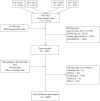The association between dietary approaches to stop hypertension diet and bone mineral density in US adults: evidence from the National Health and Nutrition Examination Survey (2011-2018)
- PMID: 38155299
- PMCID: PMC10754924
- DOI: 10.1038/s41598-023-50423-7
The association between dietary approaches to stop hypertension diet and bone mineral density in US adults: evidence from the National Health and Nutrition Examination Survey (2011-2018)
Abstract
This study aimed to investigate the relationship between the dietary approaches to stop hypertension (DASH) dietary patterns and bone mineral density (BMD) in adults residing in the United States. To achieve this, data from the National Health and Nutrition Examination Survey (NHANES) database for 2011-2018 were utilized. This study utilized the NHANES database from 2011 to 2018, with a sample size of 8,486 US adults, to investigate the relationship between the DASH diet and BMD. The DASH diet was assessed based on nine target nutrients: total fat, saturated fat, protein, fiber, cholesterol, calcium, magnesium, sodium and potassium. The primary outcome measures were BMD values at the total BMD, thoracic spine, lumbar spine, and pelvis. Multivariable linear models were employed to analyze the association between the DASH diet and BMD. Interaction tests, subgroup, and sensitivity analysis were also followed. A negative correlation was observed between the DASH diet and total BMD (OR: - 0.003 [95%CI: - 0.005, - 0.001), pelvic (OR: - 0.005 [95%CI: - 0.007, - 0.002]), and thoracic BMD (OR: - 0.003 [95%CI: - 0.005, - 0.001]). However, the DASH diet does not appear to have a particular effect on lumbar spine BMD (OR: - 0.002 [95%CI: - 0.004, 0.001]). Similarly, when the DASH diet was categorized into tertiles groups, the relationship with total BMD, pelvic BMD, thoracic BMD, and lumbar spine BMD remained consistent. Furthermore, we performed a sensitivity analysis by converting BMD to Z-scores, and the results remained unchanged. Subgroup analyses and interaction tests indicated no significant dependence of BMI, gender, smoking, hypertension, and diabetes on the observed association (all p for interactions > 0.05). The DASH diet has been identified as potentially reducing total BMD, while specifically impacting thoracic and pelvic BMD. However, it appears to have no significant effect on lumbar spine BMD.
© 2024. The Author(s).
Conflict of interest statement
The authors declare no competing interests.
Figures
Similar articles
-
Dietary Approaches to Stop Hypertension Diet, Weight Status, and Blood Pressure among Children and Adolescents: National Health and Nutrition Examination Surveys 2003-2012.J Acad Nutr Diet. 2017 Sep;117(9):1437-1444.e2. doi: 10.1016/j.jand.2017.03.026. Epub 2017 May 20. J Acad Nutr Diet. 2017. PMID: 28539258
-
Impact of metabolic syndrome on bone mineral density in men over 50 and postmenopausal women according to U.S. survey results.Sci Rep. 2024 Mar 25;14(1):7005. doi: 10.1038/s41598-024-57352-z. Sci Rep. 2024. PMID: 38523143 Free PMC article.
-
Waist-to-Height Ratio Is a Stronger Mediator in the Association between DASH Diet and Hypertension: Potential Micro/Macro Nutrients Intake Pathways.Nutrients. 2023 May 4;15(9):2189. doi: 10.3390/nu15092189. Nutrients. 2023. PMID: 37432361 Free PMC article.
-
Dietary Approaches to Stop Hypertension and risk of chronic kidney disease: A systematic review and meta-analysis of observational studies.Clin Nutr. 2020 Jul;39(7):2035-2044. doi: 10.1016/j.clnu.2019.10.004. Epub 2019 Oct 15. Clin Nutr. 2020. PMID: 31669002
-
Adherence to the dietary approaches to stop hypertension (DASH) diet in relation to all-cause and cause-specific mortality: a systematic review and dose-response meta-analysis of prospective cohort studies.Nutr J. 2020 Apr 22;19(1):37. doi: 10.1186/s12937-020-00554-8. Nutr J. 2020. PMID: 32321528 Free PMC article.
Cited by
-
Impact of Acute and Chronic Stressors on the Morphofunctional Characteristics of Long Bones in Spontaneously Hypertensive Rats: A Pilot Study Using Histological and Microtomographic Analysis.Biomedicines. 2025 Jul 10;13(7):1689. doi: 10.3390/biomedicines13071689. Biomedicines. 2025. PMID: 40722761 Free PMC article.
-
Unveiling the twin epidemics of hypertension and diabetes: a cross-sectional analysis of sex-specific prevalence, risk, and hotspots in India's epidemiological transition zones.BMC Public Health. 2025 May 10;25(1):1734. doi: 10.1186/s12889-025-22983-y. BMC Public Health. 2025. PMID: 40349007 Free PMC article.
-
The relationship between body roundness index (BRI) and suicidal ideation: evidence from NHANES 2013-2018.BMC Psychiatry. 2025 Apr 17;25(1):395. doi: 10.1186/s12888-025-06834-z. BMC Psychiatry. 2025. PMID: 40247242 Free PMC article.
-
Association between life's essential 8 and bone mineral density among adults aged 20-59 years.Sci Rep. 2025 Jan 21;15(1):2664. doi: 10.1038/s41598-025-86749-7. Sci Rep. 2025. PMID: 39838123 Free PMC article.
References
-
- Lloyd T, Eggli DF. Measurement of bone mineral content and bone density in healthy twelve-year-old white females. J. Nucl. Med. 1992;33:1143–1145. - PubMed
-
- National Center for Health Statistics. NHANES 1999–2006 DXA Multiple Imputation Data Files. Centers for Disease Control and Prevention (2023, accessed Nov 2023). https://wwwn.cdc.gov/Nchs/Nhanes/Dxa/Dxa.aspx.
MeSH terms
LinkOut - more resources
Full Text Sources
Medical


